- 1Air Resources Laboratory, NOAA, College Park, MD, United States
- 2Center for Satellite and Earth System Research and Department of Atmospheric, Oceanic and Earth Sciences, George Mason University, Fairfax, VA, United States
Remobilized volcanic ash from ground deposits can present significant hazards to human health, infrastructure, and aviation. Modeling of ash remobilization events is an important tool that can provide information on the timing and magnitude to assist in planning and response. We investigate how the horizontal resolution of meteorological data, specifically that of friction velocity provided by numerical weather prediction (NWP) models, affects the estimated vertical mass flux and modeled concentrations of volcanic ash. We then apply a method designed to reduce the influence of the resolution on these quantities. Resuspension of volcanic ash from a deposit in Iceland has been modeled with the HYSPLIT atmospheric transport and dispersion model (ATDM) driven by meteorological fields from the European Center for Medium-Range Weather Forecasts (ECMWF) ECMWF Reanalysis v5 (ERA5) dataset and the weather research and forecasting model (WRF) at different resolutions (27 km and 9 km). We tested several simple emission schemes: one widely used for both volcanic ash and dust emissions, one operationally used to forecast ash resuspension in Iceland, and one based on controlled measurements from prepared ash deposits. Scaling factors for emissions were estimated using a cumulative distribution function (CDF) matching technique. Friction velocity values varied significantly across meteorological datasets resulting in considerably different estimates of onsets and vertical mass flux. It is a common approach to compensate for these differences by applying a scaling factor and adjusting the threshold friction velocity. Here, we implement a scheme that utilizes a Weibull distribution for the friction velocity to reduce the dependence of emission estimates on meteorological data resolution. We find that all emission schemes and meteorological datasets can predict the timing of large resuspension events and subsequent transport of the resuspended material. Indeed, the coarser datasets of WRF 27 km and ERA5 perform better than the WRF 9 km in some respects. The use of Weibull distribution for friction velocity successfully reduces the dependence of emission estimates on grid resolution. Similar schemes have been used successfully for dust emissions. Reducing or eliminating this dependence is important in order to assess and compare the success of different emission schemes, threshold friction velocities, and calibration factors.
1 Introduction
For hazard planning purposes, it is important to determine the expected frequency of hazardous conditions and concentrations of ash. Atmospheric transport and dispersion models (ATDMs) are often used to model concentrations of resuspended materials such as volcanic ash and mineral dust. ATDMs require meteorological inputs, such as from a numerical weather prediction (NWP) model, analysis or reanalysis products, or observations. They also require information about the initial position and amount of the material emitted into the atmosphere. To model resuspension with a forward modeling setup, the ATDM requires information about the location of source regions and the mass of the material lifted from each source region as a function of time.
Dust and ash are resuspended by a transfer of momentum from the atmosphere to the deposit. The amount of material resuspended depends on both the state of the atmosphere and properties of the deposit (Kok et al., 2012). Detailed information about deposit properties such as grain size distribution, soil moisture, and deposit depth is not often available. Even the horizontal extent of the deposit may not be clearly known, particularly for fresh deposits of volcanic ash. Furthermore, deposit properties change over time.
An NWP model supplies information about the atmosphere, in particular, the friction velocity that characterizes the momentum flux. However, the spatial and temporal resolutions of the available data may be fairly coarse, and resuspension depends on very local conditions. The modeled mass flux of resuspended material has been shown to be sensitive to the grid resolution of the data (Ridley et al., 2013; Gueye and Jenkins, 2019; Mingari et al., 2017). Vertical mass flux from the surface is related to a high power (generally 3–5) of the friction velocity, and thus, using a mean value for this quantity over an area will provide an underestimation of the true value in case of heterogeneity. Different strategies for reducing the dependence on grid resolution have been developed, including computing emissions on a high-resolution offline grid separately (Meng et al., 2021), estimating emissions from albedo (Chappell et al., 2024), creating a mapping between high- and low-resolution dust emissions (Leung et al., 2023), reducing the threshold friction velocity for coarser resolutions (Klose et al., 2021), and using a distribution for wind speed over the grid square rather than a single value (Ridley et al., 2013; Zhang et al., 2016; Foroutan and Pleim, 2017; Menut, 2018; Tai et al., 2021). Here, we implement a version of the last strategy by utilizing a Weibull distribution for friction velocity.
The processes that govern the resuspension of volcanic ash are generally the same as those for mineral dust and sand, and thus, modeling of resuspended volcanic ash is generally similar to that of dust, but there are important differences (Langmann, 2013; Etyemezian et al., 2019; Del Bello et al., 2021). Fewer studies and measurements of volcanic ash resuspension exist. Measurements conducted by Etyemezian et al. (2019) suggest that fresh volcanic ash deposits can be much more emissive than dust, although they did find that the threshold friction velocities are similar (30–40 cm
We compare simulated concentrations of resuspended volcanic ash with observations of PM10 at five measurement stations in Iceland. We use an atmospheric transport and dispersion model, HYSPLIT, with three sets of NWP products. The measurements by Leadbetter et al. (2012) are described in Section 2.1. We then describe the modeling setup in which a matrix describing source–receptor relationships is created (Section 2.2). This modeling setup allows for different emission schemes, which are described in Section 2.3, to be applied quickly.
The emission schemes and a technique for reducing dependence on meteorological grid resolution are described in Sections 2.3 and 2.4, respectively. A cumulative distribution function (CDF) matching technique is used to compute calibration or scaling factors for the emission schemes as well as take into account the background (Section 2.5). Evaluation of the different simulations is described in Section 2.6, and results and discussion are presented in Section 3 and Section 4, respectively.
2 Materials and methods
2.1 Measurements
Measurement data are from the Environment Agency of Iceland, and the same measurement data were used in Leadbetter et al. (2012). The data consist of hourly measurements from particulate matter monitors measuring concentrations of particulates less than 10
We focus on the period of 25 May 2010 through 30 June 2010 after the cessation of the eruption of Eyjafjallojökull on 23 May 2010 (Arason et al., 2011). The locations of the measurement sites are shown in Figure 1. Two urban stations, Grensásvegur and Hvaleyrarholt, lie a couple of hundred kilometers to the west and slightly north of the source region. Three stations are located on the edge of the source region, Hvolsvöllur on the east edge, Heimaland to the southeast, and Vík to the south. Measurements of
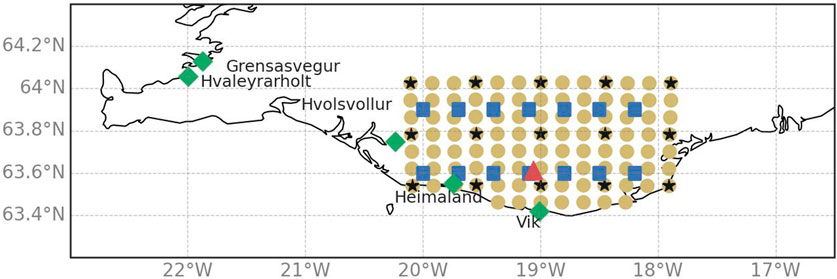
Figure 1. Map of relevant locations in Iceland. Measurements sites are marked as green diamonds. Eyjafjallojökull volcano is shown as the red triangle (
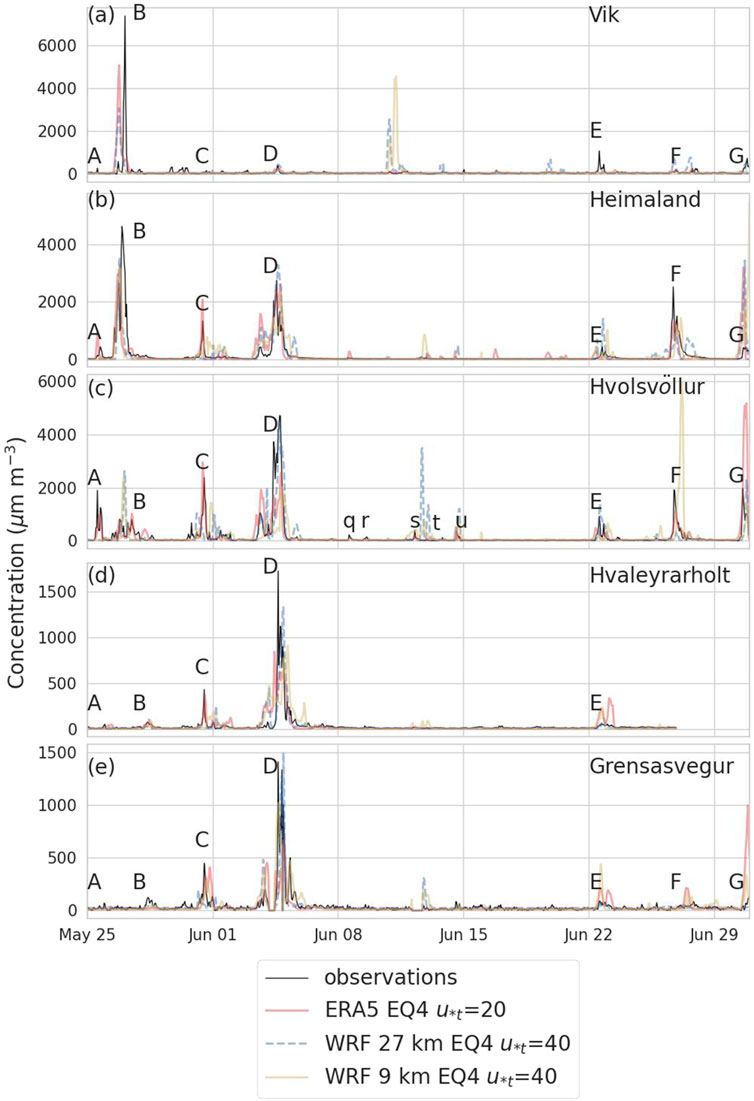
Figure 2. Measured and simulated levels of
2.2 Modeling
HYSPLIT is a Lagrangian transport and dispersion model developed by the National Oceanic and Atmospheric Administration’s Air Resources Laboratory (NOAA ARL) Draxler and Hess (1997), Draxler and Hess (1998); Stein et al. (2015). The model is used operationally at the Washington, Anchorage, Darwin, and Wellington volcanic ash advisory centers (VAACs) for modeling the transport and dispersion of volcanic ash (Beckett et al., 2024) and is also used to model dust resuspension (Draxler et al., 2001; Stein et al., 2010; Ashrafi et al., 2014; Salmabadi et al., 2023). Gridded fields from a meteorological model including the wind field, temperature, humidity, precipitation, and boundary layer height are inputs for the HYSPLIT model. In this study, we use three different meteorological datasets that are described in Section 2.2.1 as model inputs.
2.2.1 NWP modeling
Below, we discuss the meteorological datasets we use in the study and compare with previous studies on regional volcanic ash resuspension that have utilized meteorological fields with various resolutions: 12-km weather research forecasting (WRF) (Folch et al., 2014), 8-km WRF (Mingari et al., 2020), 2-km WRF (Mingari et al., 2017), and a 12-km limited area version of the NWP model from the UK Met Office (Leadbetter et al., 2012; Beckett et al., 2017). These resolutions refer to the horizontal grid spacing of the respective models.
2.2.1.1 ERA5
Data from the European Center for Medium-Range Weather Forecasts (ECMWF) ERA5 global atmospheric reanalysis (Hersbach et al., 2020) were obtained from Copernicus Climate Change and Atmospheric Monitoring Services (2018) and used as input in the HYSPLIT. The dataset has
2.2.1.2 WRF
The WRF model (Skamarock et al., 2008) version 3.5.1 was run for May through July of 2010 with horizontal resolutions of 27 km (WRF 27 km), 9 km (WRF 9 km), and 3 km (WRF 3 km). In the vertical resolution, there are 34 pressure-sigma levels, with the highest resolution observed near the surface and model top. The upper boundary of the model is at 100 hPa pressure level. The thickness of the lowest layer is approximately 16 m, and there are 20 layers below 850 hPa. The global forecast system (GFS) is used for the model’s initial and outermost lateral boundary conditions. The model is run with the MM5 similarity theory surface layer scheme to compute surface exchange coefficients for heat, moisture, and momentum (Fairall et al., 2003); the Noah land surface model to calculate surface water and energy fluxes (Chen and Dudhia, 2001); the UW planetary boundary layer scheme to compute vertical sub-grid scale fluxes due to eddy transports (Bretherton and Park, 2009); the rapid radiative transfer model for general circulation models (RRTMGs) longwave and shortwave radiation schemes (Iacono et al., 2008); the WRF single-moment 3-class microphysics scheme to predict water vapor, cloud water/ice, and rain/snow concentrations (Hong et al., 2004); and the Grell–Freitas cumulus parameterization to estimate sub-grid-scale updrafts and downdrafts associated with convection and shallow clouds using an ensemble approach that is scale-dependent to allow for a smooth transition as the horizontal resolution increases (Grell and Freitas, 2013). Observational and analysis nudging is employed in the WRF simulations. WRF output fields consist of hourly averages. Since WRF data are on a conformal grid, the grid is close to square. Grid points in the region considered for possible emissions are shown in Figure 1. The 3-km grid points are not shown, but there are nine of them for every 9-km WRF grid point.
2.2.2 HYSPLIT model setup
HYSPLIT model runs were performed, which released one unit of mass for each particle size from every source location every hour from May 22 to 30 June 2010. To reduce the computational time, the runs were only performed for source points in which the friction velocity was greater than 20 cm
Sample input files to HYSPLIT are provided in Supplementary Material and provide complete information on the model setup. HYSPLIT was run in the three-dimensional computational particle mode with a variable time step calculated by the model according to the maximum wind speed and grid spacing. Vertical velocities from the meteorological datasets were used to calculate the vertical motion.
As measurements consist of PM10, particle diameters of 1, 5, 10, and 20
The output concentration grid used for each run has a vertical resolution of 50 m and a horizontal resolution of
The emission vectors are calculated from one of the relationships described in Section 2.3. As discussed previously, Figure 1 shows the center of the source locations, which coincides with the center of the NWP grid cells. The computational particles were released from an area of the size of the grid cell centered on the grid cells.
One advantage of this setup is that once all the model runs are completed, different formulations for determining the emissions can be applied relatively quickly without running the HYSPLIT again. Although many HYSPLIT runs are needed, the individual runs are short, and they can be run in parallel. However, computational time does increase significantly at higher resolution. Here, we only use the WRF 27 km and WRF 9 km resolutions to drive HYSPLIT and leave the use of WRF 3 km for future work. The use of the WRF 3 km resolution for determining emissions is described in Section 2.4.
2.3 Emission estimates
Friction velocity is defined as the product of density and shear stress. The NWP model provides a friction velocity,
where
We consider four simple relationships between emission flux, s, in units of kg
Equation 2 is used by Beckett et al. (2017) and Hammond and Beckett (2019) with the factor
Equation 3 was formulated in Westphal et al. (1987) with
Etyemezian et al. (2019) determined
This formulation is from Marticorena and Bergametti (1995) and has been used extensively for dust and ash (Draxler et al., 2001; Folch et al., 2014; Mingari et al., 2020).
The above relationships encompass a range of common functional forms of the emission dependence on
Etyemezian et al. (2019) measured
Friction velocity can be more realistically treated as a function of deposit properties. For instance, Folch et al. (2014) and Mingari et al. (2020) implement a scheme in which
While we investigate and discuss the effect of changing
2.4 Accounting for horizontal resolution of the NWP model in the emission scheme
It is well known that many dust emission algorithms are dependent on grid resolution (Ridley et al., 2013; Meng et al., 2021; Leung et al., 2023). One way of reducing this dependence is to utilize a distribution for variables such as wind or friction velocity in the equation for emission flux.
where
where
For each grid box in the WRF 27 km dataset, there are 81 values from the WRF 3 km, and similarly for the WRF 9-km dataset, there are nine values. Figure 3a shows the standard deviation of the friction velocities in the fine resolution WRF 3-km dataset,

Figure 3. (a) Histogram of standard deviation of the WRF 3 km friction velocities vs. the friction velocity of the WRF 27 km. The red line is a linear fit to the data (Equation 10). The slope is 0.332 with standard error 0.009, the intercept is 5.13 with standard error 0.31, and the Pearson correlation coefficient (PCC) = 0.456. (b) Histogram of the mean of the WRF 3 km friction velocities vs. friction velocity of the WRF 27 km. The red line is a linear fit to the data with slope 0.822 and standard error 0.015; the intercept is 9.5 with standard error 0.4, and PCC = 0.56. The black dotted line is the 1:1 line. (c) Histogram of the shape parameter calculated from each fit of a Weibull distribution to the 81 WRF 3 km friction velocities at each location and hour. The red line is a linear fit to the points with slope of −0.001 with standard error 0.001, intercept of 2.53 with standard error of 0.04, and PCC = −0.01. The black line is
The same process is followed for the WRF 9 km and ERA5 datasets, as shown in the Supplementary Material. The relationship between
Figure 3b shows the histogram of the mean of the 81 WRF 3-km friction velocities vs. the friction velocity of the WRF 27 km, which we use to check our assumption that
Figure 3c shows the histogram of shape parameters obtained from fitting a Weibull distribution to the WRF 3 km data vs.
Following the same procedure for the WRF 9 km data produces shape parameters between approximately 4 and 5 for
Larger values of the shape parameter indicate a distribution with a narrower peak, so it makes sense that the shape parameter value will increase as the grid resolution becomes finer, and there is less variation in
Figure 4 shows examples of Weibull distributions for a time period for the 15 WRF 27- km source locations. As seen from the large scatter in Figure 3a,
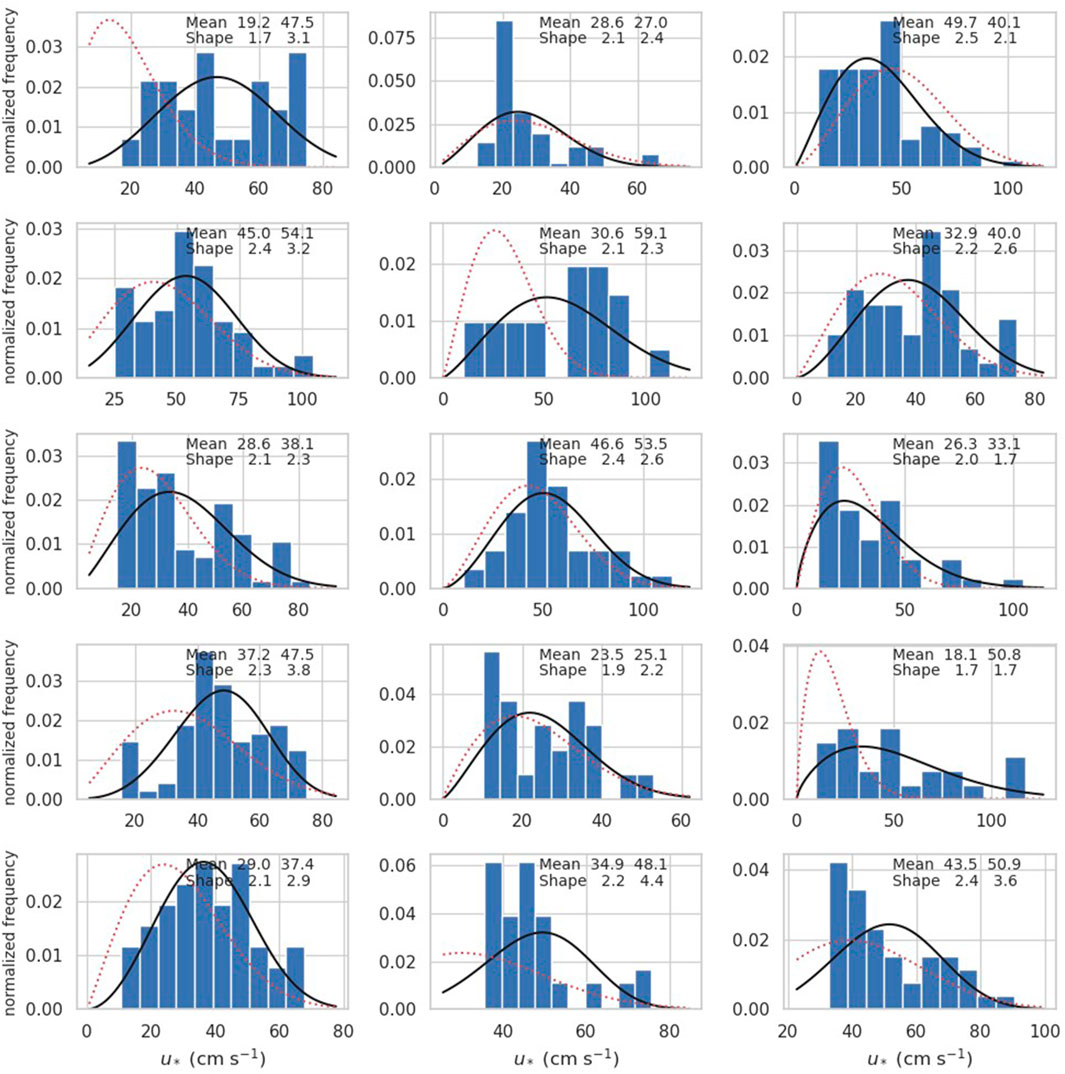
Figure 4. Each plot represents one source location in the WRF 27 km dataset and the source points in the WRF 3 km dataset which are within the WRF 27 km grid square on 01 June 2010 the time 00:00 UTC. The blue bars are the normalized histogram of WRF 3 km friction velocities. The black line is a Weibull distribution fit to the histogram. The red dotted line is a Weibull distribution computed from the friction velocity of the WRF 27 km dataset being used as an approximation for the mean and Equations 10, 8 to calculate the shape,
Figure 4 also illustrates the uncertainty in estimating the distribution and parameters from a relatively small sample size. To check the suitability of the Weibull distribution, we used a fitting program called distfit (Taskesen, 2020) to rank how well 10 different distributions fit the data according to the residual sum of squares (RSS) and found that Weibull performed the best overall (see Supplementary Material).
Our method here differs from similar work mainly in two respects. First, it uses a distribution for
2.5 Computing the scaling factor
It is a generally accepted practice to compute a scaling or calibration factor for the emission scheme by comparing simulated concentrations with observations, although the methods to do so vary (Leadbetter et al., 2012; Folch et al., 2014; Beckett et al., 2017; Mingari et al., 2020).
To compute the scaling factors,
where
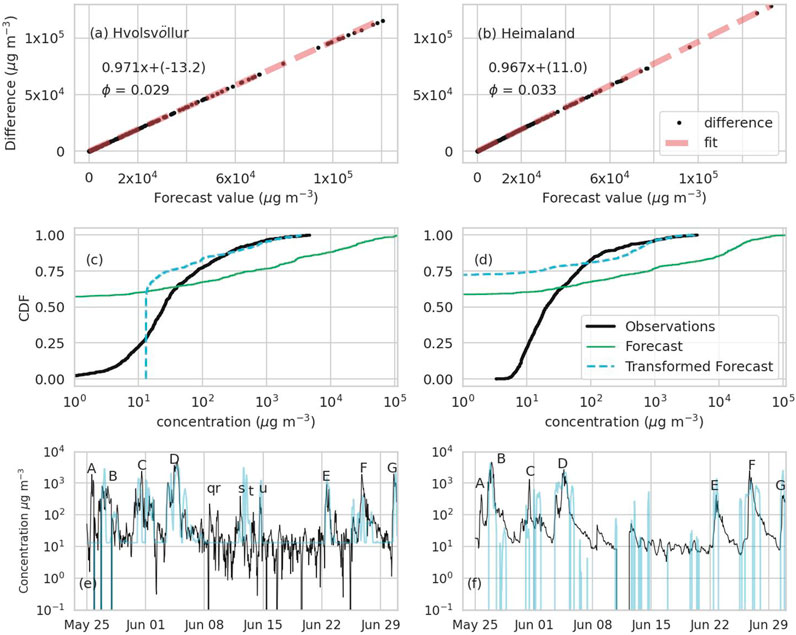
Figure 5. Examples of the CDF matching procedure at two stations, Hvolsvöllur (a, c, and e) and Heimaland (b, d, and f). The examples use the 27 km WRF dataset and Equation 3 for emissions with
The intercept can be interpreted as the background value of the observations when it is negative. The intercept only correctly represents the background when the forecast correctly captures the magnitude, duration, and number of peaks. If the simulation over-forecasts the peaks, then the background value will be shifted lower or even to a negative value (positive intercept), which is not physical. If the simulation under-forecasts the peaks, then the background value will be shifted higher.
Figures 5a, c, e show a case when the intercept is negative, which is most often the case. Figures 5b, d, f show a case when the intercept is positive. Subtracting the positive intercept then leads to negative concentrations at some times, which is not physical. An additional step could be taken to then adjust those to 0.
Here, we calculate
2.6 Evaluation
We compute statistics, root-mean-square error (RMSE), and Pearson correlation coefficient (PCC) using the forecasts adjusted individually at each station. We do not report a traditional measure of bias because it is near zero in all cases due to the use of CDF matching. This method of computing the statistics gives a best-case scenario.
We provide the ratio of the highest scaling factor to the lowest and indicate it by
3 Results
3.1 Emission estimates and friction velocity
Figure 6 shows the joint histograms of friction velocity and 10 m wind speed, as well as the relationship between
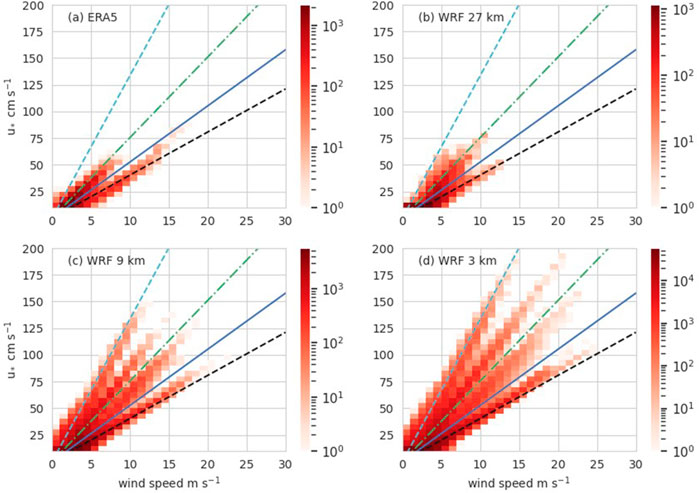
Figure 6. Two-dimensional histograms of
The time series of
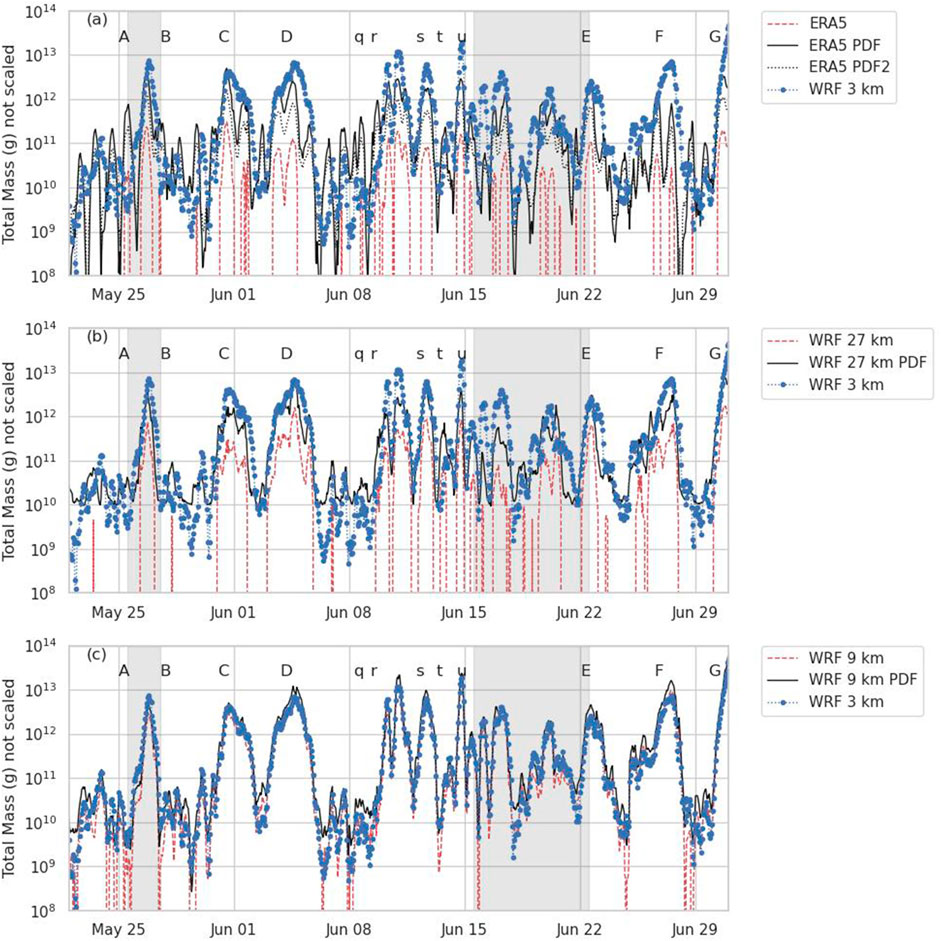
Figure 7. Time series of the total mass resuspended as predicted by Equation 4 with
The WRF 9 km and WRF 3 km data already agree fairly well, especially at the peaks, even without using a PDF for
Figure 8 is the same as Figure 7, except sources with precipitation greater than 0.01 mm

Figure 8. Same as Figure 7, except sources with precipitation greater than 0.01 mm
3.2 Modeled concentrations
Figure 2 shows modeled concentrations compared to observations at all five measurement sites. An example using each meteorological dataset is shown. Changing the emission scheme or threshold friction velocity tends to only change the magnitudes of the peaks somewhat. Qualitatively, episodes A, B, and C seem to be captured best by ERA5.
Episode A is predicted only by ERA5. Episode B is predicted at Vík by ERA5 and WRF 27 km, with the simulated arrival time being approximately 9 h too early. At Heimaland and Hvolsvöllur, all three datasets predict episode B, with the WRF datasets showing the peak to be large and sharp at Hvolsvöllur and ERA5 being closer.
Episode D is captured fairly well by all three meteorological datasets, with the WRF 27 km arguably reproducing the timing and duration of the peak the best.
At higher
Episode E is quite mixed. The WRF 27 km seems to perform the best. It shows a small peak at approximately 100
Figure 9 provides the values described in Section 2.6 for the three meteorological datasets using different emission schemes and

Figure 9. (A) Scaling factor,
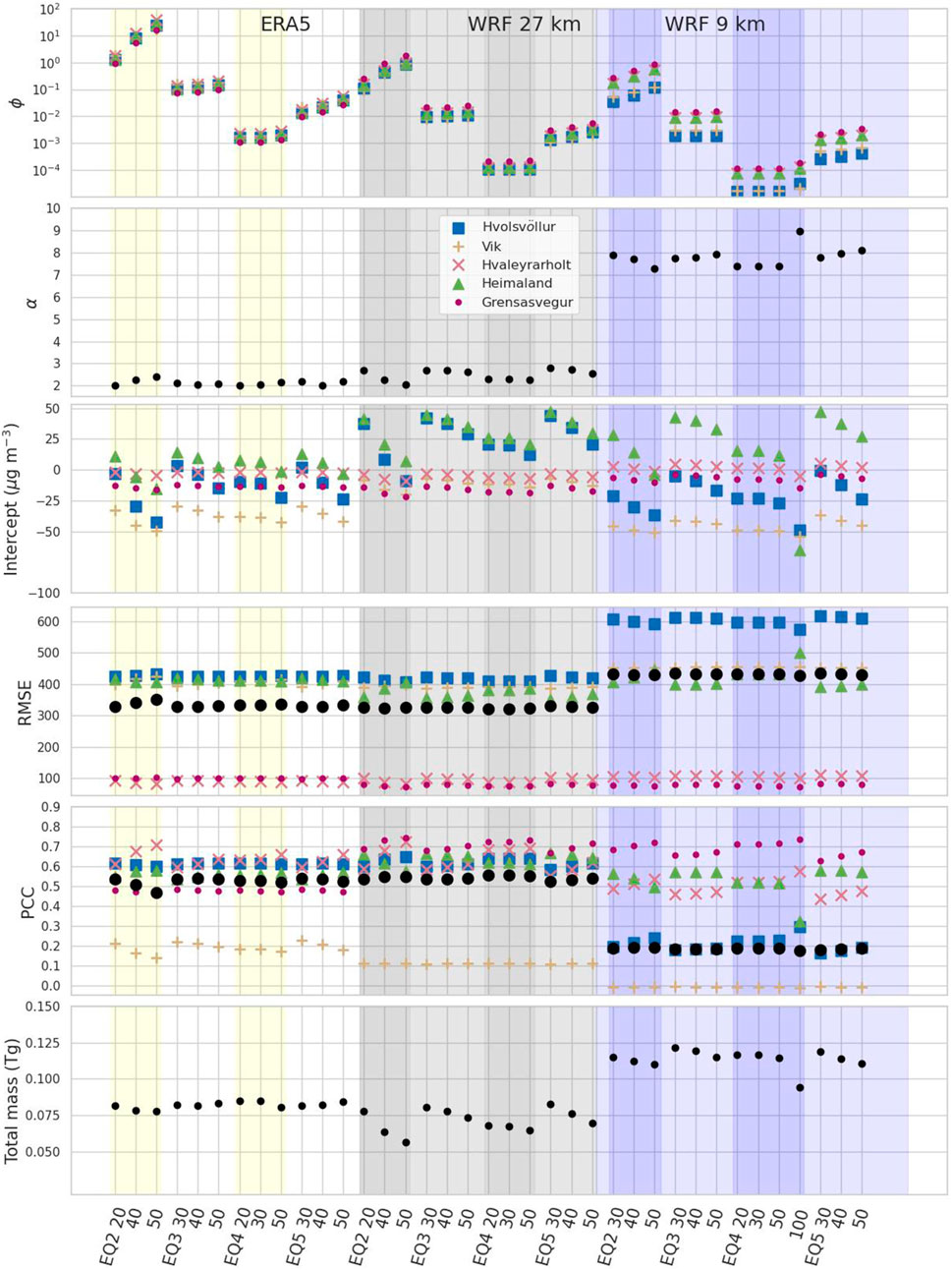
Figure 10. Same as Figure 9, except emissions were calculated with a Weibull distribution for
The three different meteorological datasets are shown in the order from the most coarse on the left to the least coarse on the right. Results for the different functional forms are shown with different values of
Simulations using the WRF 27 km and ERA5 data produced the lowest values of
Given a meteorological dataset, scaling factors were lowest for Equation 4 and highest for Equation 2. This may be expected as the scaling in Equation 2 was already computed with a similar method as given here, while Equation 4 is from point measurements of prepared bare ash samples. And thus, the scaling factor must account for adjustments such as drag partition (King et al., 2005).
The scaling factor tends to increase as
Figure 11 compares the scaled emission flux as a function of
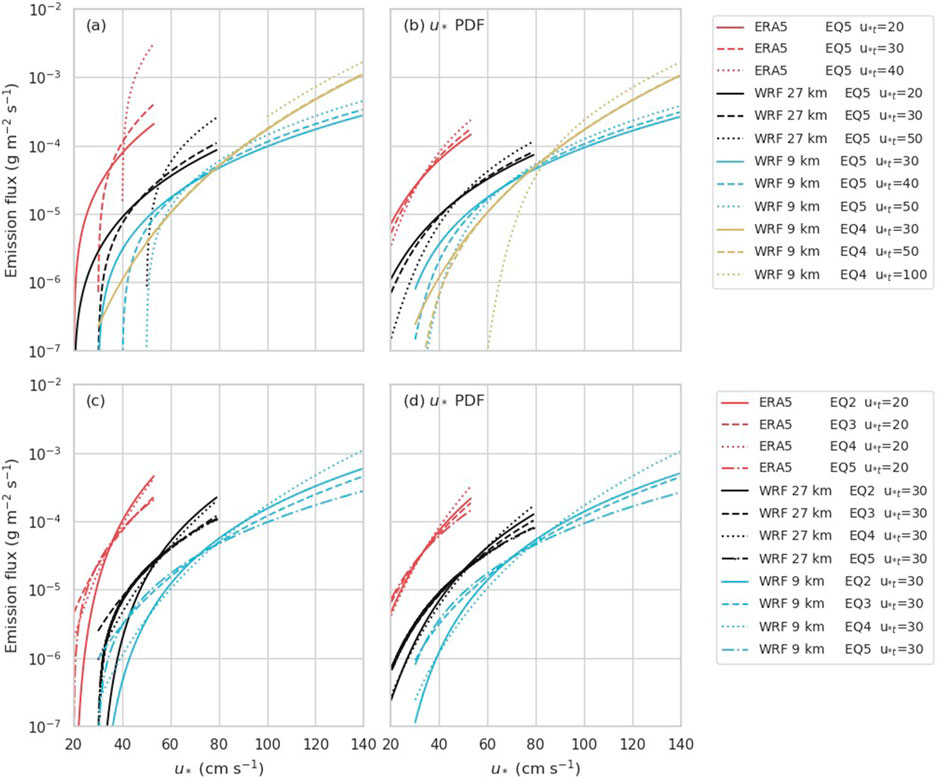
Figure 11. Scaled emission flux as a function of friction velocity. The median scaling factor from all five measurement sites was used. Figures (a) and (b) show the effect of changing
On the other hand, estimates using ERA5 are quite sensitive to
The total mass suspended was estimated to be approximately 0.075 Tg for ERA5, between 0.05 TG and 0.075 TG for WRF 27 km, and approximately 0.11 Tg for WRF 9 km. The different scaling factors tend to preserve the total mass resuspended. According to Gudmundsson et al. (2012), the total amount of airborne tephra produced by the eruption was
Given an emission equation, scaling factors were highest for ERA5 and lowest for WRF 9 km. This is related to the range of
Figures 12, 13 illustrate the effect of using the distribution for
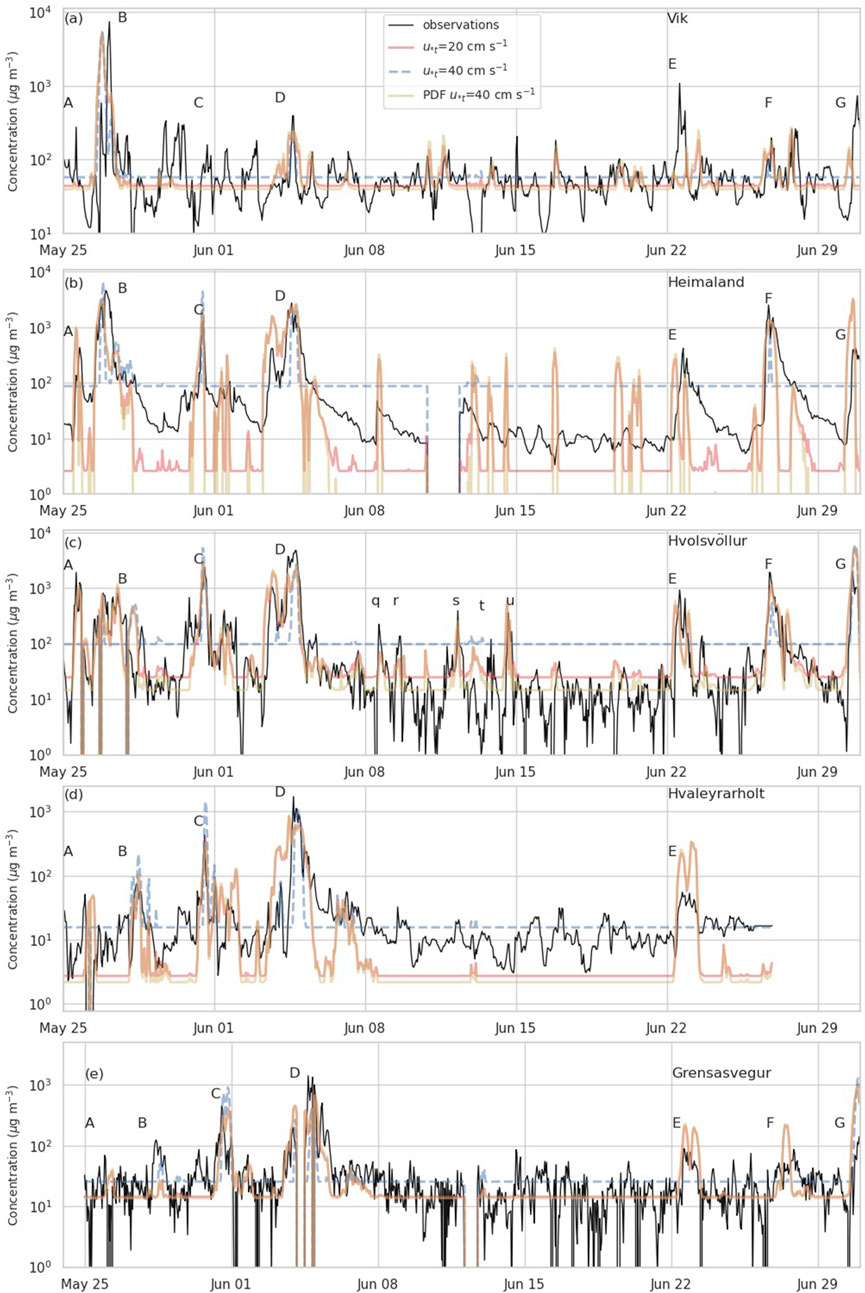
Figure 12. Measured and simulated levels of
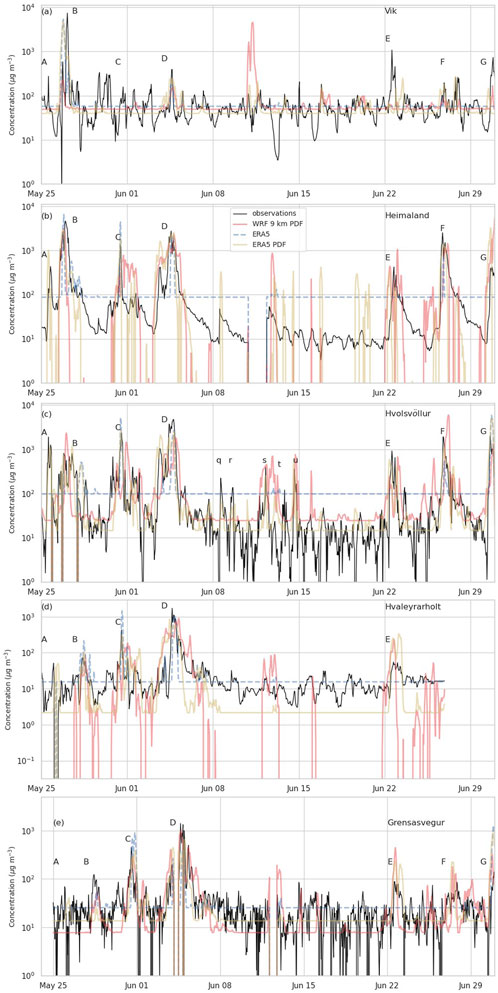
Figure 13. Measured and simulated levels of
However, using the distribution has advantages over simply reducing
As shown in Figure 10, the only relationship that produces scaling factors near 1 is Equation 2. A scaling factor near 1 indicates agreement with the scaling factor determined by Beckett et al. (2017). Folch et al. (2014) determined a scaling factor of 0.1 for Equation 3, which is similar to what we see for ERA5 with the Weibull distribution for
Negative values of intercept from the CDF matching that agree with the background indicate that the model is correctly capturing the amount of mass in the peaks. Positive values of the intercept from the CDF matching indicate a high bias or over-forecasting of peaks. We see this only at the Heimaland station for most of the WRF 9-km runs and a few of the WRF 27-km runs. We also see large negative values of the intercept occurring particularly when
RMSE is significantly lower at the two distal stations, Grensásvegur and Hvaleyrarholt. It is similar across all simulations, with the exception that the RMSE for Hvolsvöllur for the WRF 9 km dataset is significantly higher. PCC also decreases significantly, and visual inspection confirms that peaks produced by the WRF 9 km dataset at this station tend to be offset slightly in time. Overall, the WRF 27 km dataset also produces simulations with the highest PCC.
Arguably, the most important performance metric shown here is
We looked at the effect of using different particle sizes along with the Weibull distribution by repeating the analysis carried out so far with different particle sizes in place of the 5
4 Discussion
This investigation mainly focused on reducing differences in estimated emissions due to differences in meteorological grid size. Utilizing methods to account for meteorological grid resolution has several advantages. It should allow for better agreement in scaling factors and optimal threshold friction velocities in different modeling setups. In many areas, it may allow the use of coarser meteorological data for operational forecasting purposes to save on computational resources while not sacrificing much in forecast quality.
It is also an important component in adapting experimental measurements on relationships between
Some schemes utilize the model roughness
Here, we focused on simulating large remobilization events and obtaining agreement between emission estimates from 27 km, 9 km, and 3 km grid resolutions. The peak emissions estimates from 9 km to 3 km resolutions were similar even without the use of the distribution for
Something this investigation hinted at but could not fully explore was that using a distribution for
One potential weakness of the approach is the need to determine the shape parameter,
Data availability statement
The raw data supporting the conclusions of this article will be made available by the authors, without undue reservation.
Author contributions
AC: conceptualization, investigation, methodology, software, visualization, writing – original draft, and writing – review and editing. CL: methodology, software, writing – original draft, and writing – review and editing. DT: methodology and writing – review and editing. AS: conceptualization, funding acquisition, project administration, and writing – review and editing.
Funding
The author(s) declare that financial support was received for the research and/or publication of this article. Initial work on the resuspension of volcanic ash was supported by the U.S. Department of Energy (DOE), Office of River Protection (ORP), through Interagency Agreement DE-EM0003822.
Acknowledgments
The authors thank Vic Etyemezian and Jack Gillies at Desert Research Institute for providing the data used for Equation 4 and information about drag partitioning. Data were provided courtesy of the Environment Agency of Iceland and Susan Leadbetter.
Conflict of interest
The authors declare that the research was conducted in the absence of any commercial or financial relationships that could be construed as a potential conflict of interest.
Generative AI statement
The author(s) declare that Generative AI was used in the creation of this manuscript. This manuscript utilized content generated with the assistance of ChatGPT (January 2025 version, GPT-4 architecture), developed by OpenAI (https://openai.com). The AI was used solely for editing the manuscript in response to reviewer comments. The output was reviewed and edited by the authors to ensure accuracy and relevance.
Publisher’s note
All claims expressed in this article are solely those of the authors and do not necessarily represent those of their affiliated organizations, or those of the publisher, the editors and the reviewers. Any product that may be evaluated in this article, or claim that may be made by its manufacturer, is not guaranteed or endorsed by the publisher.
Supplementary material
The Supplementary Material for this article can be found online at: https://www.frontiersin.org/articles/10.3389/feart.2025.1511847/full#supplementary-material
References
Arason, P., Petersen, G. N., and Bjornsson, H. (2011). Observations of the altitude of the volcanic plume during the eruption of Eyjafjallajökull, April–May 2010. Earth Syst. Sci. Data 3, 9–17. doi:10.5194/essd-3-9-2011
Ashrafi, K., Shafiepour-Motlagh, M., Aslemand, A., and Ghader, S. (2014). Dust storm simulation over Iran using HYSPLIT. J. Environ. Health Sci. Eng. 12, 9. doi:10.1186/2052-336X-12-9
Beckett, F., Bensimon, D., Crawford, A., Deslandes, M., Guidard, V., Hort, M., et al. (2024). VAAC model setup tables 2023. Zenodo. doi:10.5281/zenodo.10671098
Beckett, F., Kylling, A., Siguroardottir, G., von Loewis, S., and Witham, C. (2017). Quantifying the mass loading of particles in an ash cloud remobilized from tephra deposits on Iceland. Atmos. Chem. Phys. 17, 4401–4418. doi:10.5194/acp-17-4401-2017
Beckett, F., Witham, C., Hort, M., Stevenson, J., Bonadonna, C., and Millington, S. (2016). Sensitivity of dispersion model forecasts of volcanic ash clouds to the physical characteristics of the particles. J. Geophys. Res. Atmos. 120. doi:10.1002/2015JD023609
Belitz, K., and Stackelberg, P. E. (2021). Evaluation of six methods for correcting bias in estimates from ensemble tree machine learning regression models. Environ. Model. and Softw. 139, 105006. doi:10.1016/j.envsoft.2021.105006
Bonadonna, C., and Phillips, J. C. (2003). Sedimentation from strong volcanic plumes. J. Geophys. Res. Solid Earth 108. doi:10.1029/2002JB002034
Bretherton, C., and Park, S. (2009). A new moist turbulence parameterization in the Community Atmosphere Model. J. Clim. 22, 3422–3448. doi:10.1175/2008jcli2556.1
Chappell, A., Hennen, M., Schepanski, K., Dhital, S., and Tong, D. (2024). Reducing resolution dependency of dust emission modeling using albedo-based wind friction. Geophys. Res. Lett. 51. doi:10.1029/2023GL106540
Chen, F., and Dudhia, J. (2001). Coupling an advanced land-surface-hydrology model with the Penn State-NCAR MM5 modeling system. part i: model implementation and sensitivity. Mon. Weather Rev. 129, 569–585. doi:10.1175/1520-0493(2001)129<0569:caalsh>2.0.co;2
Copernicus Climate Change and Atmospheric Monitoring Services (2018). ERA5 dataset. Contains modified copernicus climate change service information.
Crawford, A., Chai, T., Wang, B., Ring, A., Stunder, B., Loughner, C. P., et al. (2022). Evaluation and bias correction of probabilistic volcanic ash forecasts. Atmos. Chem. Phys. 22, 13967–13996. doi:10.5194/acp-22-13967-2022
Dare, R. A. (2015). Sedimentation of Volcanic ash in the HYSPLIT dispersion model. Tech. Rep. No. 079, Centre Aust. Weather Clim. Res. Collaboration for Australian Weather and Climate Research (CAWCR).
Del Bello, E., Taddeucci, J., Merrison, J., Rasmussen, K., Andronico, D., Ricci, T., et al. (2021). Field-based measurements of volcanic ash resuspension by wind. Earth Planet. Sci. Lett. 554, 116684. doi:10.1016/j.epsl.2020.116684
Del Bello, E., Taddeucci, J., Merrison, J. P., Alois, S., Iversen, J. J., and Scarlato, P. (2018). Experimental simulations of volcanic ash resuspension by wind under the effects of atmospheric humidity. Sci. Rep. 8, 14509. doi:10.1038/s41598-018-32807-2
Dominguez, L., Bonadonna, C., Forte, P., Jarvis, P. A., Cioni, R., Mingari, L., et al. (2020). Aeolian remobilisation of the 2011-cordón caulle tephra-fallout deposit: example of an important process in the life cycle of volcanic ash. Front. Earth Sci. 7. doi:10.3389/feart.2019.00343
Draxler, R., Gillette, D., Kirkpatrick, J., and Heller, J. (2001). Estimating pm10 air concentrations from dust storms in Iraq, Kuwait and Saudi Arabia. Atmos. Environ. 35, 4315–4330. doi:10.1016/S1352-2310(01)00159-5
Draxler, R. R., and Hess, G. D. (1997). Description of the HYSPLIT_4 modeling system. Tech. Rep. arl-224. Silver Spring, MD: NOAA Air Resources Laboratory.
Draxler, R. R., and Hess, G. D. (1998). An overview of the HYYSPLIT_4 modeling system for trajectories, dispersion, and deposition. Aust. Meteorol. Mag. 47, 195–308.
Etyemezian, V., Gillies, J. A., Mastin, L. G., Crawford, A., Hasson, R., Van Eaton, A. R., et al. (2019). Laboratory experiments of volcanic ash resuspension by wind. J. Geophys. Research-Atmospheres 124, 9534–9560. doi:10.1029/2018JD030076
Fairall, C., Bradley, E., Hare, J., Grachev, A. A., and Edson, J. (2003). Bulk parameterization of air-sea fluxes: updates and verification for the COARE algorithm. J. Clim. 16, 571–591. doi:10.1175/1520-0442(2003)016<0571:bpoasf>2.0.co;2
Fécan, F., Marticorena, B., and Bergametti, G. (1999). Parametrization of the increase of the aeolian erosion threshold wind friction velocity due to soil moisture for arid and semi-arid areas. Ann. Geophys. 17, 149–157. doi:10.1007/s00585-999-0149-7
Folch, A., Mingari, L., Osores, M. S., and Collini, E. (2014). Modeling volcanic ash resuspension - application to the 14-18 October 2011 outbreak episode in central Patagonia, Argentina. Nat. Hazards Earth Syst. Sci. 14, 119–133. doi:10.5194/nhess-14-119-2014
Foroutan, H., and Pleim, J. E. (2017). Improving the simulation of convective dust storms in regional-to-global models. J. Adv. Model. Earth Syst. 9, 2046–2060. doi:10.1002/2017MS000953
Ganser, G. H. (1993). A rational approach to drag prediction of spherical and nonspherical particles. Powder Technol. 77, 143–152. doi:10.1016/0032-5910(93)80051-b
Gillette, D. A., Fryrear, D. W., Gill, T. E., Ley, T., Cahill, T. A., and Gearhart, E. A. (1997). Relation of vertical flux of particles smaller than 10 μm to total aeolian horizontal mass flux at Owens Lake. J. Geophys. Res. Atmos. 102, 26009–26015. doi:10.1029/97JD02252
Grell, G., and Freitas, S. (2013). A scale and aerosol aware stochastic convective parameterization for weather and air quality modeling. Atmos. Chem. Phys. 14, 5233–5250. doi:10.5194/acp-14-5233-2014
Gudmundsson, L., Bremnes, J. B., Haugen, J. E., and Engen-Skaugen, T. (2012a). Technical note: downscaling RCM precipitation to the station scale using statistical transformations - a comparison of methods. Hydrology Earth Syst. Sci. 16, 3383–3390. doi:10.5194/hess-16-3383-2012
Gudmundsson, M. T., Thordarson, T., Höskuldsson, A., Larsen, G., Björnsson, H., Prata, F. J., et al. (2012b). Ash generation and distribution from the April-May 2010 eruption of Eyjafjallajökull, Iceland. Sci. Rep. 2, 572. doi:10.1038/srep00572
Gueye, M., and Jenkins, G. S. (2019). Investigating the sensitivity of the WRF-Chem horizontal grid spacing on pm10 concentration during 2012 over West Africa. Atmos. Environ. 196, 152–163. doi:10.1016/j.atmosenv.2018.09.064
Hammond, K., and Beckett, F. (2019). Forecasting resuspended ash clouds in Iceland at the London VAAC. Weather 74, 167–171. doi:10.1002/wea.3398
Hersbach, H., Bell, B., Berrisford, P., Hirahara, S., Horányi, A., Muñoz-Sabater, J., et al. (2020). The era5 global reanalysis. Q. J. R. Meteorol. Soc. 146, 1999–2049. doi:10.1002/qj.3803
Hong, S.-Y., Dudhia, J., and Chen, S. H. (2004). A revised approach to ice microphysical processes for the bulk parameterization of clouds and precipitation. Mon. Weather Rev. l132, 103–120. doi:10.1175/1520-0493(2004)132<0103:aratim>2.0.co;2
Iacono, M., Delamere, J., Mlawer, E., Shephard, M. W., Clough, S. A., and Collins, W. D. (2008). Radiative forcing by long-lived greenhouse gases: calculations with the AER radiative transfer models. J. Geophys. Res. 113, D13103. doi:10.1029/2008JD009944
King, J., Nickling, W. G., and Gillies, J. A. (2005). Representation ofvegetation and other nonerodible elements in aeolian shear stress partitioning models for predicting transport threshold. J. Geophys. Res. 110, F04015. doi:10.1029/2004jf000281
Klose, M., Jorba, O., Goncalves Ageitos, M., Escribano, J., Dawson, M. L., Obiso, V., et al. (2021). Mineral dust cycle in the multiscale online nonhydrostatic atmosphere chemistry model (monarch) version 2.0. Geosci. Model Dev. 14, 6403–6444. doi:10.5194/gmd-14-6403-2021
Klose, M., and Shao, Y. (2012). Stochastic parameterization of dust emission and application to convective atmospheric conditions. Atmos. Chem. Phys. 12, 7309–7320. doi:10.5194/acp-12-7309-2012
Klose, M., and Shao, Y. (2013). Large-eddy simulation of turbulent dust emission. Aeolian Res. 8, 49–58. doi:10.1016/j.aeolia.2012.10.010
Klose, M., Shao, Y., Li, X., Zhang, H., Ishizuka, M., Mikami, M., et al. (2014). Further development of a parameterization for convective turbulent dust emission and evaluation based on field observations. J. Geophys. Research-Atmospheres 119, 10441–10457. doi:10.1002/2014JD021688
Kok, J. F., Parteli, E. J. R., Michaels, T. I., and Bou Karam, D. (2012). The physics of wind-blown sand and dust. Rep. Prog. Phys. 75, 106901. doi:10.1088/0034-4885/75/10/106901
Langmann, B. (2013). Volcanic ash versus mineral dust: atmospheric processing and environmental and climate impacts. Int. Sch. Res. Notices 2013, 1–17. doi:10.1155/2013/245076
Leadbetter, S. J., Hort, M. C., von Löwis, S., Weber, K., and Witham, C. S. (2012). Modeling the resuspension of ash deposited during the eruption of Eyjafjallajökull in spring 2010. J. Geophys. Res. 117, D00U10. doi:10.1029/2011jd016802
Leung, D. M., Kok, J. F., matLi, L., Okin, G. S., Prigent, C., Klose, M., et al. (2023). A new process-based and scale-aware desert dust emission scheme for global climate models - part I: description and evaluation against inversemodeling emissions. Atmos. Chem. Phys. 23, 6487–6523. doi:10.5194/acp-23-6487-2023
MacKinnon, D. J., Clow, G. D., Tigges, R. K., Reynolds, R. L., and Chavez, . P. S. (2004). Comparison of aerodynamically and model-derived roughness lengths (z0) over divers surfaces, central Mojave Desert, Californa, USA. Geomorphology 63, 103–113. doi:10.1016/j.geomorph.2004.03.009
Marticorena, B., and Bergametti, G. (1995). Modeling the atmospheric dust cycle: 1. design of a soil-derived dust emission scheme. J. Geophys. Res. 100, 16415–16430. doi:10.1029/95jd00690
Marticorena, B., Bergametti, G., Aumont, B., Callot, Y., N’Doumé, C., and Legrand, M. (1997). Modeling the atmospheric dust cycle: 2. simulation of saharan dust sources. J. Geophys. Res. Atmos. 102, 4387–4404. doi:10.1029/96JD02964
Meng, J., Martin, R. V., Ginoux, P., Hammer, M., Sulprizio, M. P., Ridley, D. A., et al. (2021). Grid-independent high-resolution dust emissions (v1.0) for chemical transport models: application to ‘GEOS-Chem (12.5.0). Geosci. Model Dev. 14, 4249–4260. doi:10.5194/gmd-14-4249-2021
Menut, L. (2018). Modeling of mineral dust emissions with a Weibull wind speed distribution including subgrid-scale orography variance. J. Atmos. Ocean. Technol. 35, 1221–1236. doi:10.1175/JTECH-D-17-0173.1
Mingari, L., Folch, A., Dominguez, L., and Bonadonna, C. (2020). Volcanic ash resuspension in Patagonia: numerical simulations and observations. Atmosphere 11, 977. doi:10.3390/atmos11090977
Mingari, L. A., Collini, E. A., Folch, A., Baez, W., Bustos, E., Soledad Osores, M., et al. (2017). Numerical simulations of windblown dust over complex terrain: the Fiambala Basin episode in June 2015. Atmos. Chem. Phys. 17, 6759–6778. doi:10.5194/acp-17-6759-2017
Piani, C., Weedon, G. P., Best, M., Gomes, S. M., Viterbo, P., Hagemann, S., et al. (2010). Statistical bias correction of global simulated daily precipitation and temperature for the application of hydrological models. J. Hydrology 395, 199–215. doi:10.1016/j.jhydrol.2010.10.024
Reichle, R. H., and Koster, R. D. (2004). Bias reduction in short records of satellite soil moisture. Geophys. Res. Lett. 31. doi:10.1029/2004gl020938
Ridley, D. A., Heald, C. L., Pierce, J. R., and Evans, M. J. (2013). Toward resolution-independent dust emissions in global models: impacts on the seasonal and spatial distribution of dust. Geophys. Res. Lett. 40, 2873–2877. doi:10.1002/grl.50409
Salmabadi, H., Saeedi, M., Roy, A., and Kaskaoutis, D. G. (2023). Quantifying the contribution of middle eastern dust sources to pm10 levels in Ahvaz, Southwest Iran. Atmos. Res. 295, 106993. doi:10.1016/j.atmosres.2023.106993
Skamarock, W. C., Klemp, J. B., Dudhia, J., Gill, D. O., Barker, D. L., Duda, M. G., et al. (2008). A description of the advanced research WRF version 3. NCAR technical note. Boulder, CO: NCAR/TN-475+STR, NCAR.
Stein, A. F., Draxler, R. R., Rolph, G. D., Stunder, B. J. B., Cohen, M. D., and Ngan, F. (2015). NOAA’s HYSPLIT atmospheric transport and dispersion modeling system. Bull. Amer. Meteor. Soc. 96, 2059–2077. doi:10.1175/bams-d-14-00110.1
Stein, A. F., Wang, Y., De La Rosa, J. D., Sanchez De La Campa, A. M., Castell, N., and Draxler, R. R. (2010). Modeling PM10 originating from dust intrusions in the southern iberian peninsula using HYSPLIT. Weather Forecast. 26, 236–242. doi:10.1175/waf-d-10-05044.1
Tai, A. P., Ma, P. H., Chan, Y.-C., Chow, M.-K., Ridley, D. A., and Kok, J. F. (2021). Impacts of climate and land cover variability and trends on springtime East Asian dust emission over 1982–2010: a modeling study. Atmos. Environ. 254, 118348. doi:10.1016/j.atmosenv.2021.118348
Taskesen, E. (2020). Distfit is a python library for probability density fitting. Available online at: https://erdogant.github.io/distfit v1.4.0
Virtanen, P., Gommers, R., Oliphant, T. E., Haberland, M., Reddy, T., Cournapeau, D., et al. (2020). SciPy 1.0: fundamental algorithms for scientific computing in Python. Nat. Methods 17, 261–272. doi:10.1038/s41592-019-0686-2
Webb, N. P., Chappell, A., LeGrand, S. L., Ziegler, N. P., and Edwards, B. L. (2020). A note on the use of drag partition in aeolian transport models. Aeolian Res. 42, 100560. doi:10.1016/j.aeolia.2019.100560
Westphal, D. L., Toon, O. b., and Carlson, T. (1987). A two-dimensional numerical investigationof the dynamics and microphysics of Saharan dust storms. J. Geophys. Res. 92, 3027–3049. doi:10.1029/jd092id03p03027
Keywords: volcanic ash, resuspension, atmospheric transport and dispersion, HYSPLIT, dust, Eyjafjallajökull, remobilization, emissions schemes
Citation: Crawford AM, Loughner CP, Tong DQ and Stein AF (2025) Reducing dependence of modeled resuspended volcanic ash on meteorological grid resolution. Front. Earth Sci. 13:1511847. doi: 10.3389/feart.2025.1511847
Received: 15 October 2024; Accepted: 23 May 2025;
Published: 18 June 2025.
Edited by:
Jack Gillies, Desert Research Institute (DRI), United StatesReviewed by:
Mattia De’ Michieli Vitturi, National Institute of Geophysics and Volcanology (INGV), ItalyYiyang Luo, V. N. Karazin Kharkiv National University, Ukraine
Copyright © 2025 Crawford, Loughner, Tong and Stein. This is an open-access article distributed under the terms of the Creative Commons Attribution License (CC BY). The use, distribution or reproduction in other forums is permitted, provided the original author(s) and the copyright owner(s) are credited and that the original publication in this journal is cited, in accordance with accepted academic practice. No use, distribution or reproduction is permitted which does not comply with these terms.
*Correspondence: Alice M. Crawford, YWxpY2UuY3Jhd2ZvcmRAbm9hYS5nb3Y=
 Alice M. Crawford
Alice M. Crawford Christopher P. Loughner1
Christopher P. Loughner1